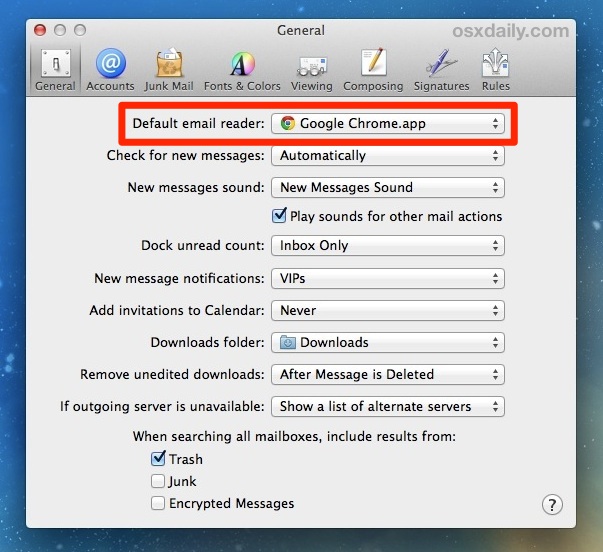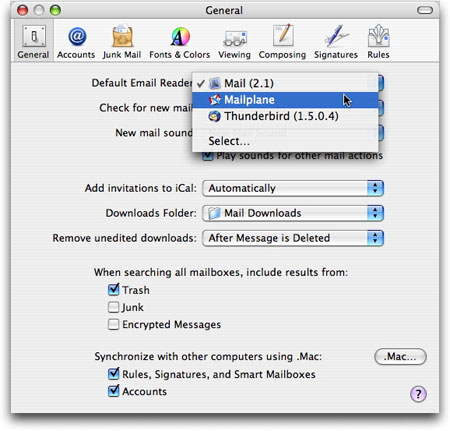

- How to set default mail client in chrome for mac#
- How to set default mail client in chrome install#
- How to set default mail client in chrome windows 8#
- How to set default mail client in chrome download#
- How to set default mail client in chrome windows#

Through the icon you can also access your inbox, unread messages, and "Compose mail" screen quickly. (Yep, you need to configure this in Mail even when Mail is what you don't want to use.)īesides directing clicks on mailto: links to Gmail, the Google Notifier comes with some additional features: It adds an icon (like this: ) in the menu bar and notifies you (if configured to do so) about new mail in your Gmail box.

While options like Webmailer also do the job, I'll mention yet another way for the sake of completeness: (The remainder of this answer is now obsolete.) Gmail in Google Chrome already opens all email links by default, if you want Google mail to do the same in Firefox, then follow the steps mentioned below. If you're using Chrome, this is now very simple: open settings, search for "mailto", and set Gmail as the handler for mailto.
How to set default mail client in chrome for mac#
Turns out Google Notifier for Mac is no longer supported. :)Īlternative way, if you need to do this programmatically. Answer the question correctly this time.Click the current app listed under 'Email' in this case 'Outlook 2016' and choose your normal web browser.
How to set default mail client in chrome windows#
Type 'default apps' in the Windows start menu. If you are using gmail you can set Chrome and gmail as the default mail application to address the issue.

Open Control Panel on the Desktop and click Default Programs.
How to set default mail client in chrome windows 8#
If you made a mistake and selected "No" and you really wanted to select "Use Gmail" Set Default Windows 8 Desktop Email Client.
How to set default mail client in chrome install#
If you change your mind or email service, you want to open Safari’s preferences and click the “Extensions” tab then “Uninstall” to remove the extension, or “Options” to reopen the configuration page.You do NOT need to install a third party app.īoth Google Chrome and Firefox support this functionality. You should perform a web search or consult your email’s knowledge base for what that URL would be. You can click “Custom URL” at the bottom and add it. Note, if your email isn’t represented in this list. Now, when you click upon mailto: links, your email service should open in a compose tab. Choose your mail service and then restart Safari. And set default mail reader back to Mail. So to reset that, I went to Mail > Prefs > General. So I look for a solution to set up Zimbra webmail as default mail client throught GPO (for mailto links among others). After discussions, we decided to define Zimbra webmail only on Firefox and Chrome. So even if you turn off Gmail as the email handler inside Chrome, it is still set on the OS level. Local IT manager asks me if we can define Zimbra webmail as default mail client (I know that a webmail isn't an email client, it is a website.).
How to set default mail client in chrome download#
Once you download the extension and install it, a configuration screen will open. Note: Once you set Gmail as your email handler, on the OS side (at least on mac), Chrome is set as the systems email handler. Type default apps in the Windows start menu. The mailto extension works for more than simply Gmail. This is true even if you set up gmail as your default email client. We searched for an easy method (keyword: easy) such as a setting or configuration file, but the only way to reliably do this in Safari is using the mailto extension (it’s also available for Opera and Chrome). Unfortunately, Safari doesn’t have a simple way to set applications handlers. Okay, so those are third-party browsers, but what about Apple’s own Safari browser, which a great number of Mac users use by default? Scroll through the “Content Type” until you find “mailto” and then choose your default “Action” from the right column. Open the preferences (“Command + ,”) and click the “Applications” tab.


 0 kommentar(er)
0 kommentar(er)
